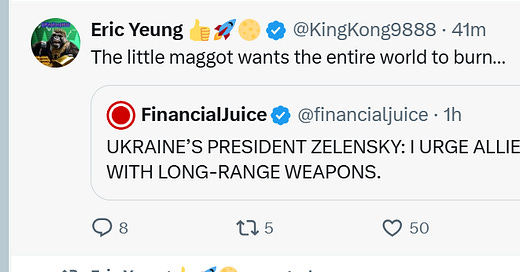China Sells 1.2 Million Bitcoin Valued at 111 Billion Dollars or 3.7 Billion Silver ounces. NOW DO THE MATH ON HOW MANY YEARS OF SILVER MINING THAT IS.
US sending Missiles into Russia. Why are we at war with Russia?
The recent escalation in the Ukraine conflict, marked by Ukraine's use of U.S.-made ATACMS missiles to strike targets in Russia's Bryansk region, signals a perilous turning point in the war. This unprecedented action not only demonstrates Ukraine's growing military capabilities but also highlights significant vulnerabilities in Russia's air defenses, potentially inviting further retaliatory measures from Moscow. The implications are grave: Dmitry Medvedev, a prominent Russian official, has threatened nuclear retaliation against Kyiv and NATO countries, underscoring the heightened risk of a broader conflict that could spiral out of control. The stakes are alarmingly high as both sides appear entrenched, with Russia showing no signs of retreating from its aggressive posture.
As Donald Trump prepares to assume office again in January, his rhetoric around peace negotiations contrasts sharply with the Biden administration's recent military maneuvers. Trump's campaign has promised a swift resolution to the conflict, yet the current administration seems intent on ramping up military support for Ukraine, possibly driven by fears of losing influence before Trump's policies take effect. This frantic push for military aid raises unsettling questions about the Biden administration's strategy and motivations, especially given the backdrop of escalating violence and threats from Russia.
The U.S. foreign policy of sending missiles into Russian territory is not merely reckless; it is a dangerous gamble that could provoke a catastrophic response. With tensions already at a boiling point, this approach risks igniting a conflict that could engulf Europe and beyond. The world must recognize that escalating military actions only serve to deepen divisions and increase the likelihood of a devastating confrontation. A diplomatic path must be prioritized over militarization to avert disaster and foster lasting peace in the region.
Scholars like John Mearsheimer and Jeffrey Sachs have long critiqued the West's approach to the conflict, arguing that a more conciliatory stance towards Russia could yield better outcomes for global stability. Mearsheimer contends that NATO expansion provoked Russia, while Sachs emphasizes the need for a diplomatic resolution rather than military escalation.
Trump’s campaign rhetoric has centered on a promise of peace, claiming he could resolve the Ukraine crisis swiftly. His potential policies suggest a shift away from the current administration's robust support for Ukraine, raising alarms about an impending realignment in international relations.
As Trump prepares to take office in January, the Biden administration appears to be ramping up military aid to Ukraine, perhaps in a desperate bid to solidify U.S. influence before a possible withdrawal under Trump’s leadership.
This frantic push for military assistance raises unsettling questions about Biden's motivations. Is he acting out of a sense of urgency, or is there an underlying fear that his administration’s time is limited? The narrative that Biden is an aging leader desperate to leave a legacy could explain this reckless escalation.
Sending missiles into Russian territory not only risks igniting further conflict but also undermines any chance for a diplomatic resolution that could stabilize the region.
The current trajectory of U.S. foreign policy appears dangerously misguided. Rather than seeking avenues for peace, the Biden administration seems intent on escalating tensions with Russia, potentially leading to catastrophic consequences. As we stand on the brink of a new era in U.S.-Russia relations, it is imperative to reconsider our approach and prioritize diplomacy over militarization. The stakes are too high for reckless decisions that could plunge us into an even deeper conflict.
end of segment
China is selling 1.2 million Bitcoin, signaling a shift in its approach to cryptocurrency as it no longer considers Bitcoin a strategic asset.
Cryptocurrency trading is strictly illegal for Chinese citizens, reinforcing the government's stance against digital currencies.
Moreover, China has lowered the threshold on the Shanghai Gold Exchange by 40%, aiming to attract smaller buyers and encouraging its citizens to invest in gold and silver instead.
This move aligns with China's broader strategy to promote gold and silver as more stable investment options compared to volatile cryptocurrencies.
This table illustrates that 1.2 million Bitcoin at the current price of $92,374 would be worth approximately $110.85 billion. If this entire amount were used to purchase silver at $30 per ounce, it would equate to about 3.69 billion ounces of silver.










Let’s hope they dump it all on the market in one tranche. That would cause a few maxis to need to find a men’s room. With a shower.